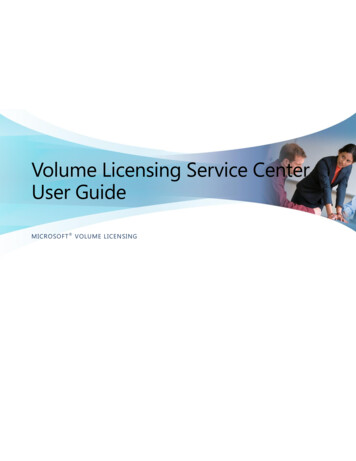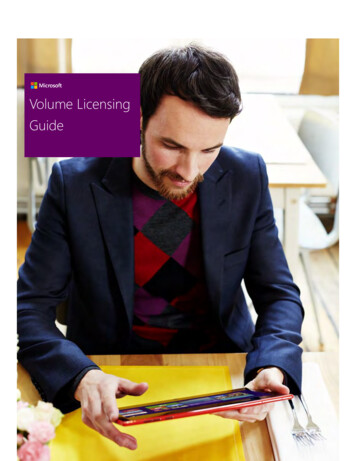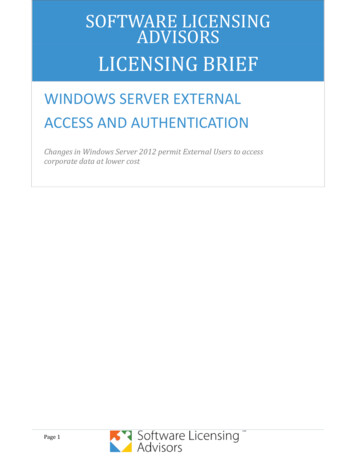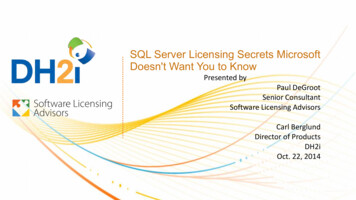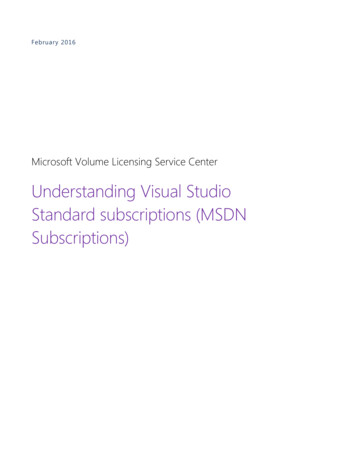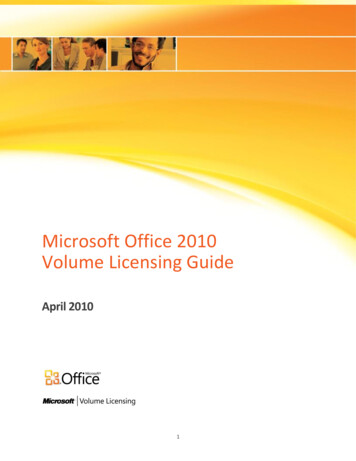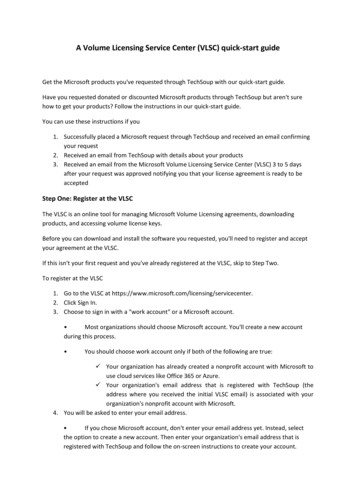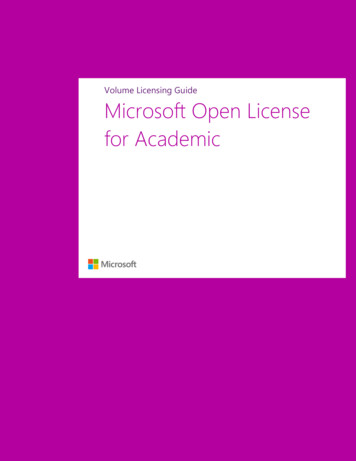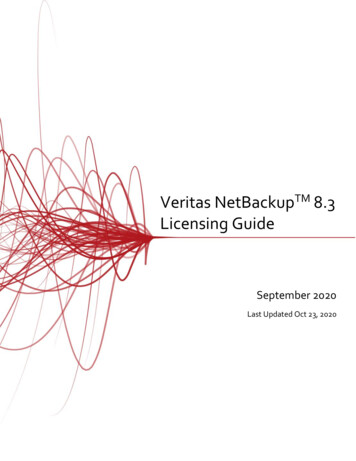
Transcription
Guide to Microsoft Volume LicensingGuide to MicrosoftVolume LicensingOctober 2013i
Guide to Microsoft Volume LicensingTable of ContentsChapter 1: Introduction to Microsoft Volume Licensing . 1How to Use This Guide . 1Keys to Understanding Microsoft Volume Licensing . 2Programs for Your Organization Type and Size . 2Programs for Public Sector and Other Organizations . 3Microsoft Payment Solutions. 4Chapter 2: Choosing a Volume Licensing program for your commercial organization . 5Microsoft Open Programs . 6Microsoft Open Program Family: Three Options . 6Microsoft Select Plus Agreement . 9Microsoft Enterprise Agreement . 12Comparing Volume Licensing Programs . 19Chapter 3: Choosing a Volume Licensing program for your government organization . 21Worldwide Government Licensing . 21United States Government Licensing . 21Home Use Program for Government Employees . 22Choosing the Right Option . 22Comparing Volume Licensing Programs for Government . 24Taking the Next Step . 25More Resources . 25Chapter 4: Choosing a Volume Licensing program for your charitable organization . 26Transactional Licensing . 26How to Acquire Charity Discounts. 26More Resources . 27Chapter 5: Choosing a Volume Licensing program for your school or university . 28Transactional Licensing . 28October 2013ii
Guide to Microsoft Volume LicensingSubscription Licensing . 29How to Acquire Academic Discounts . 30Work at Home . 30MSDN Academic Alliance Membership . 30Student Licensing . 31Taking the Next Step . 31Chapter 6: Microsoft Volume Licensing Programs for Software and Service Partners . 32ISV Royalty Licensing Program . 32Services Provider License Agreement . 34Resources. 35Chapter 7: Using Products Licensed Through a Microsoft Volume Licensing Program . 36Product Licensing Models . 36Resources and Tools . 46Managing Your Licenses . 46Chapter 8: Microsoft Software Assurance for Volume Licensing . 48Software Assurance Benefit Eligibility . 48Available Benefits . 48Getting Software Assurance . 50Microsoft Open Programs and Software Assurance . 50Microsoft Select Plus and Software Assurance . 50Microsoft Enterprise Agreement and Software Assurance . 50Taking the Next Step . 51October 2013iii
Guide to Microsoft Volume LicensingChapter 1: Introduction to Microsoft Volume LicensingAcquiring software licenses through Microsoft Volume Licensing is different than acquiring retail boxed softwarelicenses. A retail software license is usually sold in a box and contains media (floppy disk, CD-ROM, or DVD format), auser’s guide, access to product support, and Microsoft Software License Terms (formerly known as the End UserLicense Agreement or EULA). The Software License Terms dictate how customers can and cannot use the software.Software acquired through Microsoft Volume Licensing is a software license only that gives users the right to run aMicrosoft software product. Customers can save above retail boxed software prices when they participate in aMicrosoft Volume Licensing program. By acquiring software licenses through Volume Licensing, you pay for only thesoftware license and not for additional materials. With some Microsoft Volume Licensing programs, you can alsopurchase Microsoft Software Assurance for Volume Licensing. This single, cost-effective program can help boostorganizational productivity with 24 hours a day, seven days a week (24 7) support, deployment planning services,user and technical training, and the latest Microsoft software releases and unique technologies.When you acquire software through a Microsoft Volume Licensing program, you can choose to acquire media (orsupplemental media), documentation, and product support separately via download or physical media as needed.How to Use This GuideThis guide is an overview of the key features of Microsoft Volume Licensing programs. The information is presentedby organizational type and size—two of the most important keys to determining your best Volume Licensing option.The key chapters by organizational type are the following: Commercial Business Academic Government Charity Software and Service PartnersEach chapter also contains information about the additional benefits and resources that are available with eachprogram, such as software asset tracking tools, maintenance programs, and online management services. At the endof each chapter are a quick feature comparison chart and an online selection tool.In addition, separate chapters provide overviews of the following two key areas that apply to all Volume Licensingprograms in varying manners and are worthy of a more in-depth understanding: Product Use Rights (PUR), which provides an overview of product-specific terms and conditions that govern howMicrosoft products can be used in the Volume Licensing programs Software Assurance, which helps customers boost productivity across their organizations by providing newproduct versions, deployment planning, support, training, and unique technologies in one cost-effective programNovember 20131
Guide to Microsoft Volume LicensingKeys to Understanding Microsoft Volume LicensingThe following are a few key organizational characteristics to help you understand Microsoft Volume Licensing policiesand programs and to choose the best option for your organization: The size and type of your organization The products you want to license The way in which you want to use those productsPrograms for Your Organization Type and SizeAt the most elementary level, Microsoft Volume Licensing program models address organizations in the following twomain categories: Organizations with more than five but fewer than 250 computers Organizations with more than 250 computersFor organizations with fewer than 250 computers, the Microsoft Open Programs provide volume discounts for aminimal up-front cost and are widely available through the worldwide partner channel. Open Programs provide thefollowing three purchasing license options for commercial businesses: Open Value is for organizations with as few as five desktop PCs and offers the advantages of SoftwareAssurance, simplified license management, and an annual payment structure. The Open Value program offersCompany-wide, Non–Company-wide options. Open Value Subscription is for customers who want to subscribe to, rather than acquire, Microsoft productlicenses. Available in select countries or regions, Microsoft Open Value Subscription provides the lowest up-frontcosts of the Open Programs with the flexibility to reduce their total licensing costs in years when their desktop PCcount declines. Open License is for customers who want a minimum initial purchase of only five software licenses. This programis ideal if you prefer to pay-as-you-go and change your licensing program as your business grows. You canqualify for volume purchasing under the volume feature of Open License. Open volume purchasing is forcustomers who can meet minimum purchase levels using a system of product pools and points. With an entryminimum of 500 points from a single product pool, this program offers deeper discounts for a greater savings.For organizations with 250 or more desktop PCs, Microsoft offers the following options: Microsoft Select Plus is for midsize and large organizations with 250 or more desktop PCs with multipleaffiliates that want to license software and services at any business unit level while still getting the price savingadvantages of being a single organization. Microsoft Enterprise Agreement (EA) is for larger organizations that want to standardize their desktop ITacross the enterprise, but retain the flexibility to purchase Microsoft software licenses and cloud services fordifferent types of users. Based on a three-year enrollment term, it provides the deepest pricing discounts and theadvantages of Software Assurance. Microsoft Enterprise Subscription Agreement (EAS) is a Volume Licensing program for large organizationsthat want to subscribe to—rather than purchase—Microsoft software licenses. This program provides similaradvantages as the Enterprise Agreement with a lower initial cost based on a three-year subscription and theability to increase or decrease subscription counts on an annual basis. However, unlike the EA where you retainperpetual use rights for the licenses you purchase, with this subscription agreement, you gain access to Microsoftsoftware for only as long as you maintain your subscription.In addition to size, you need to consider your organization’s primary function. For example, additional discounts aregiven to some public sector organizations such as schools and universities.November 20132
Guide to Microsoft Volume LicensingPrograms for Public Sector and Other OrganizationsFor public sector organizations with fewer than 250 PCs, Microsoft offers customized versions of the Open Programs:Open License, Open Value, and Open Value Subscription. The Open License for Academic and Open License forGovernment programs are similar to the commercial Open License program, but with different pricing and partnerchannels. In some countries or regions, government organizations can also participate in the Open Value forGovernment and Open Value Subscription for Government programs. In some countries or regions, charitableorganizations can participate in the Open License for Charities program. Check with your Microsoft reseller foravailability.Government and education organizations with more than 250 PCs can participate in the Select Plus program.Government organizations can also participate in the Enterprise Agreement program.For education institutions that prefer to license their software on an annual subscription basis, Microsoft offers twounique programs: Microsoft Enrollment for Education Solutions (for higher education institutions andprimary/secondary schools) and Microsoft School Enrollment (for primary/secondary schools only).Microsoft also offers programs that can meet the specific needs of organizations that partner with Microsoft toprovide additional software and services, such as the Microsoft Independent Software Vendor (ISV) Royalty LicensingProgram and the Microsoft Services Provider License Agreement (SPLA).Licensing on-premise softwareAnother key factor to consider—aside from organizational type and size—is which products you need to license.Different product families require different licensing models. For example, a desktop PC program, such as anyMicrosoft Office 2013 suite, requires a license for each device that is running the program. Customers can install anynumber of copies and any prior version on the device or on a network device.A desktop PC operating system, such as the Windows 8.1 Pro operating system, requires a license for each deviceaccessing the licensed product (locally and remotely). Note: Only one copy can be installed on the device.In Volume Licensing, the desktop PC operating system license is an “upgrade license.” You can only acquire upgradelicenses for devices for which you have already licensed a “qualifying operating system,” either preinstalled on a PCthrough a PC manufacturer or as full-package product (FPP) from retail. The Product List shows the “qualifyingoperating systems” that qualify for an upgrade license and is available at the Volume Licensing website uct-licensing.aspx.Meanwhile, most server products require a license for each running instance of the server software you run on aserver—whether in a physical or virtual operating system environment (OSE). However, some products providebroader use rights. For example, a Windows Server 2012 R2 Standard edition operating system license permits arunning instance in up to two virtual operating system environments, plus one host instance on the physical devicesolely to manage the virtual instances at a time on the licensed server. With some products, such as Windows Server2012 R2 Datacenter edition, any number of instances can run simultaneously. Both Windows Server 2012 R2 Standardand Datacenter editions require that each physical processor be licensed on the licensed server in addition to everyvirtual instance running at any given time on Windows Server 2012 R2 Standard.Server operating system products require a Microsoft Client Access License (CAL) for each user or device that accessesthe server software. CALs are version specific and must be the same version or later than the server software beingaccessed. You can also use the Windows Server 2012 CAL to access a server running Windows Server 2012 R2. CALspermit access to servers licensed by the same entity. They do not permit access to another entity’s licensed servers.Licensing Microsoft Cloud ServicesIn addition to traditional on-premises software licenses, Microsoft offers subscriptions to cloud services through theMicrosoft Online Subscription Program. How you add cloud services through your Volume Licensing agreementdepends on the following two factors:November 20133
Guide to Microsoft Volume Licensing The type of Volume Licensing agreement you have The date that specific cloud services are made commercially availableFor organizations with more than 250 PCs, we recommend that you add Microsoft Online Services through a VolumeLicensing program such as the Enterprise Agreement. See Chapter 2 Choosing a Volume Licensing Program for YourOrganization for more details. Smaller organizations should choose the Microsoft Online Subscription Program(MOSP) at www.microsoft.com/online.Microsoft Payment SolutionsMicrosoft Payment Solutions provides commercial and public sector customers with an affordable and predictableway to acquire the IT solutions that businesses need to help cut costs and increase efficiencies. Microsoft PaymentSolutions can help you focus on what matters most: finding the best IT solution to support the success of yourbusiness.Microsoft works with multiple financing providers in 14 countries around the world to offer world-class financingsolutions under the Microsoft Payment Solutions program. Our solution partners work with you to define yourtechnology-related business needs and objectives, set up a payment structure that works with your budget, and helpyou maintain cash flow.Microsoft Payment Solutions helps customers by providing one financing resource for all their IT needs, includingsoftware, services, or your product offerings. For organizations that already license software from Microsoft, flexiblepayment options are convenient and allow them to spread out the costs of the software during an extended period oftime, thus preserving cash resources.We offer a simple and easy method of lending without any additional fees. Typically, no down payment is required,and terms range from two to five years, making it easy to match your payments to your business operations andimmediately begin to realize IT benefits.Microsoft Payment Solutions helps you be strategic with your IT purchases in the following ways: Get the IT solution you need to achieve business goals. Manage software, services (such as deployment), partner products, and hardware as one investment. Align IT benefits with costs. Enjoy a fast, easy, and responsive lending process.Find out how a predictable and affordable payment structure can help you get the IT you need and stay on budget.Visit the Microsoft Payment Solutions home page at www.microsoft.com/financing for more details.November 20134
Guide to Microsoft Volume LicensingChapter 2: Choosing a Volume Licensing program for yourcommercial organizationMicrosoft offers a variety of programs to help businesses of all sizes manage how they purchase software licenses.These programs cover everyone, from smaller organizations with a handful of desktop PCs to multinationalorganizations that manage tens of thousands of client and server units.Volume discounts are the most obvious benefit of these programs. But Volume Licensing programs also helporganizations with the following tasks: Tracking software use to ensure legal compliance Deploying updates and new versions, especially on desktop PCs Organizing software license purchasing through centralized purchasing practicesIn general, Microsoft Volume Licensing commercial programs align to two main categories: programs for companieswith fewer than 250 desktop PCs and programs for companies with more than 250 desktop PCs.For organizations with up to 250 desktop PCs, the Microsoft Open Programs: Open Value, Open Value Subscription,and Open License have flexible, low-entry requirements. Open Programs offer three choices to meet an organization’sspecific needs, and they are all available from resellers, solution providers, and online vendors.For organizations with 250 or more PCs, Microsoft offers the Microsoft Open Value, Open Value Subscription,Microsoft Enterprise Agreement, Enterprise Subscription Agreement, and Select Plus options through Microsoft LargeAccount Resellers (LARs) and Microsoft Enterprise Software Advisors (ESAs). Both LARs and ESAs offer flexibility inpayment schedules.All organizations can also subscribe to Online Services through the Microsoft Online Subscription Program.November 20135
Guide to Microsoft Volume LicensingMicrosoft Open ProgramsOrganizations with fewer than 250 PCs1Open Program offerings are a convenient and simple way for corporate, academic, charity , and government2organizations with at least five desktop PCs to acquire the latest Microsoft technology. These offerings providevolume discounts for a minimal up-front cost and are available broadly through a worldwide partner channel.Although Microsoft Open Programs are available to any size organization, they are most often used by organizationswith fewer than 250 desktop PCs. The Open Programs offer many benefits, including the following: Simplicity. Start using licensed products as soon as your order is placed through the Open License pay-as-yougo model. Affordability. All Open Programs offer flexible payment options so that you can stretch your softwareprocurement budgets further than retail license purchase options. Flexibility. A broad worldwide partner channel ensures that you have convenient and fast access to thousands ofsoftware titles. Value. Manage licenses easily and conveniently through the Microsoft Volume Licensing Service Center (VLSC).Microsoft Open Program Family: Three OptionsMicrosoft Open Programs provide multiple purchasing options, including Open Value (Company-wide or Open ValueNon–Company-wide), Open Value Subscription, and Open License.Open ValueThe Open Value program is a flexible and affordable way to use and manage Microsoft licensed products under asingle agreement. The program is a three-year term commitment that includes Software Assurance as a fixed benefit.The Open Value program has the following three options from which to choose.Company-wide Option (5 Qualified Devices Minimum)Open Value Company-wide offers commercial and government organizations additional savings when theystandardize all of their desktop PCs on one or more Microsoft enterprise products. With this single platform option,you can customize your desktop PCs by choosing separate components, including the desktop operating system,Microsoft Office suites, and CAL suites, plus additional software products selected in your agreement that include thefollowing platform product options: Desktop operating system: Windows Pro Upgrade Microsoft Office suite: Microsoft Office Professional Plus CAL suites: Microsoft Core CAL Suite, Windows Small Business Server CAL Suite, and Enterprise CAL SuiteThe Open Value Company-wide option includes discounts on company (organization)-wide deployment.Non–Company-wide Option (5 Qualified Devices Minimum)If you need licenses for servers or for a limited number of desktop PCs, you can open a Non–Company-wideAgreement for any product license purchases.1Not available for charitable organizations in all countries/regions. Check with your reseller regarding current availability.2Open Value for Government is an option for government organizations with up to 250 desktop PCs.November 20136
Guide to Microsoft Volume LicensingOpen Value Subscription (5 Qualified Devices Minimum)Open Value Subscription offers flexible annual payments tied to the number of desktop PCs you have and the lowestup-front costs. The benefits include: Additional savings in the first year if you have current or previous versions of company-wide licensed products. The option to add the company-wide licensed products you have selected on new desktop PCs throughout the yearat no additional cost for that year. Lower payment through the years as your desktop PC count declines.Like the Company-wide option, the Subscription option offers the Single-Platform option to standardize desktop PCsoftware across your organization with a customizable platform that allows you to mix and match components.Platform OptionWith both Open Value Company-wide and Open Value Subscription, you can choose to standardize desktop PClicensed products across your organization on all three components on the platform (desktop operating systems,Microsoft Office suites, and CAL suites) and receive additional savings. The platform option provides the simplest wayto manage desktop PC licenses because you do not need to track which version is installed on which desktop PC.November 20137
Guide to Microsoft Volume LicensingOpen LicenseOpen License is a two-year term commitment that is ideal for organizations that want a minimum initial purchase offive software licenses. This program is also great for a growing organization’s changing business needs because it hasa pay-as-you-go model.Open License Volume Purchase Option: If you are purchasing larger volumes of Microsoft software licenses but stillprefer to pay as you go, the volume option is a two-year term commitment with product pools and points. It providesdeeper per-unit discounts, resulting in significant savings if the volume of software licenses is high enough.To participate in the Open License Volume Purchase option, you must meet a minimum purchase level of 500 points.Points are determined by the software product mix and license quantity you plan to purchase. Because the volumeoption uses product pools and points to calculate the 500-point minimum purchase, it is important to understand theproduct pools and points formula.Product pools group similar Microsoft software products to achieve deeper volume pricing discounts. The followingare some examples:The applications pool includes products such as the Microsoft Office suites, Microsoft Project, Microsoft Visiodrawing and diagramming software, and the Microsoft Visual Studio development system.The systems pool includes the Windows operating system upgrades such as Windows 8.1 Pro.The server pool includes products like Microsoft SQL Server Standard Edition database software and MicrosoftExchange Server.Point values are assigned to each licensed product. For example: Microsoft Office Professional Plus is worth 4 points. Windows Server Standard is worth 15 points.By adding the number of points earned, you can determine whether you meet the minimum purchase requirement.For a full list of point values, refer to the Product List at tlicensing.aspx.November 20138
Guide to Microsoft Volume LicensingMicrosoft Select Plus AgreementMore value for midsize to large organizationsThe Microsoft Select Plus license program is ideal for midsize and large organizations with 250 or more desktop PCsthat also have mixed software requirements. In addition, it is ideal for customers who want transactional licensepurchasing. Select Plus increases purchasing flexibility with automatic price savings based on purchase volume acrossthe entire organization, improves asset management, and gives you the ability to license and manage your softwareassets and services at the organization, affiliate, or department level.Select Plus offers many ben
Software acquired through Microsoft Volume Licensing is a software license only that gives users the right to run a Microsoft software product. Customers can save above retail boxed software prices when they participate in a Microsoft Volume Licensing program. By acquiring software licenses through Volume Licensing, you pay for only the
